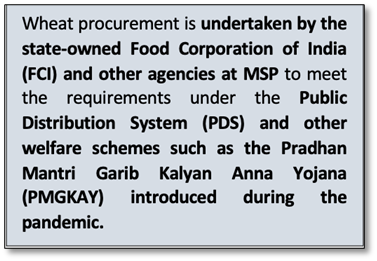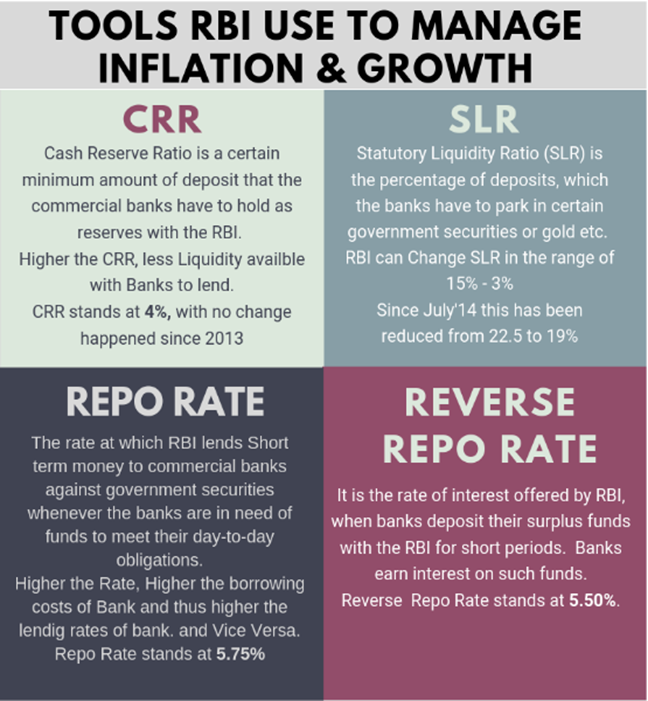Friday, 13th May 2022
Retail Inflation rises to record high
In News
Official data revealed that retail inflation had grown by 7.8% in April 2022, highest in the last eight years.
Recent figures of CPI inflation or retail inflation
- Retail Inflation faced by Indian consumers shot up to a nearly eight-year high of 7.8% in April from 6.95% in March, with rural inflation accelerating to 8.4% and urban parts of the country experiencing 7.1% inflation, as per data released by the National Statistical Office.
- April’s inflation is the seventh straight month when inflation rate has gone up.
- Retail inflation has been high since October 2019. According to law, since October 2016, the RBI is required to maintain retail inflation at a level of 4% with a tolerance of 2% i.e., between 2%-6%.
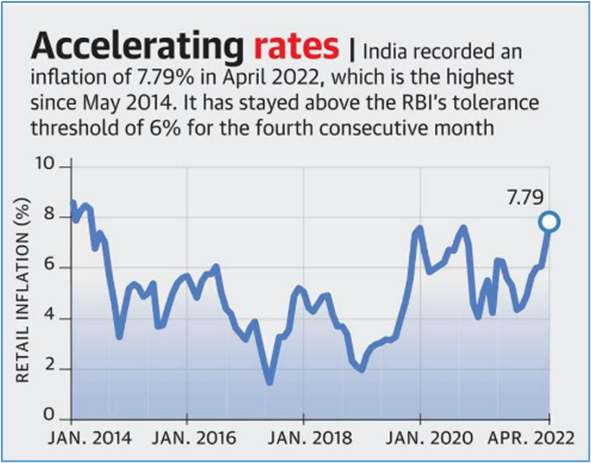
What is causing the rise in inflation figures?
- There are three main categories in CPI:
- FOOD ITEMS, which account for 46% of the Index.
- FUEL & LIGHT, with a weight of 7%.
- CORE, all other items, which make up the remaining 47%.
- And in 2020-21, when the pandemic hit the economy, food prices rose (7.3%) and even core inflation rose by 5.5%, but fuel price inflation remained low (1.3% in 2019-20 and 2.7% in 2020-21.)
- In 2021-22, the year when the global economy started recovering sharply, even though food price inflation moderated to 4%, fuel prices rose by 11.3% and core inflation went up to 6%.
- In the current financial year, it is estimated that all three components will experience an inflation rate of 6% or more.
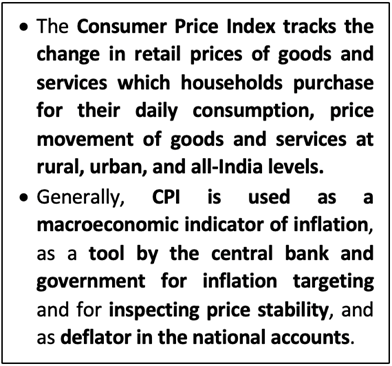
Likely impacts of Inflation
- Reduced people’s purchasing power: Coupled with reduced incomes and job losses, rising inflation means that people will have less money to spend on commodities and services.
- Reduced overall demand: Typically, non-essential demands such as a vacation get curtailed while households focus on the essentials. This affects the GDP growth rate.
- Harms savers and helps borrowers: High inflation eats away the real interest earned from keeping one’s money in the bank or similar savings instruments.
- Helps the government meet debt obligations: As the nominal GDP rises because of inflation (without necessarily implying an increase in overall production), the same amount of fiscal deficit (borrowing) become a smaller percentage of the GDP.
- Worsens the exchange rate: High inflation means the rupee is losing its power and, if the RBI doesn’t raise interest rates fast enough, investors will increasingly stay away because of reduced returns.
- Expectations of higher inflation: Persistently high inflation changes the psychology of people. People expect future prices to be higher and demand higher wages. But this, in turn, creates its own spiral of inflation as companies try to price goods and services even higher.
Sources:
Global food policy report 2022
In News
The International Food Policy Research Institute (IFPRI) has recently released its annual report presenting existing evidence around the links between food and climate.
About the News
- The report also highlights the requirement of scaling up of investment for areas such as research and development and reappropriating agricultural subsidies.
- Food systems are “inseparably linked” to the climate change crisis and transforming — through both adaptation and mitigation — the way the world grows, transports, and eats its food.
What are the major findings of the report?
- Risk of hunger: Regional differences in access to food will force nearly 500 million people at risk of going hungry.
- Food production: Baseline projections indicate that global food production will grow by about 60% over 2010 levels by 2050 in the context of climate change.
- Production and demand are projected to grow more rapidly in developing countries, particularly in Africa, than in developed countries, due to projected growth in population and incomes.
- Food pattern: Diets preferences are shifting toward higher-value foods, including more fruits and vegetables, processed foods, and animal-source foods, outside of high-income countries.
- Demand for non-veg: Meat production is projected to double in South Asia and West and Central Africa by 2030 and triple by 2050.
- Processed foods: The demand for processed foods also shows up in the growing production of oil crops and by 2050 the production is expected to more than double in Southeast Asia and West and Central Africa.
- Fruits and vegetables: Its production is projected to grow more than double in most regions including Central and West Asia and North Africa by 2050.
- Per capita consumption: Despite growth, per capita consumption levels in developing countries will remain less than half of those in developed countries.
Findings for India:
- Temperature: The average temperature across India is projected to rise by between 2.4°C and 4.4°C by 2100. Similarly, summer heat waves are projected to triple by 2100 in India.
- Hunger: Due to climate change the number of Indians at risk from hunger in 2030 is expected to be9 million in 2030 and, if the effects of climate change were to be factored in, it would increase to 90.6 million.
- Food production: India’s food production could drop 16% and the aggregate food production index would, under similar conditions, drop from 1.6 to 1.5.
- Calorie consumption: On a positive note, climate change will not impact the average calorie consumption of Indians and this is projected to remain roughly the same at 2,600 kcal per capita per day by 2030 even in a climate change scenario.
Sources:
Ujjwala scheme
In News
As per an RTI reply, 90 lakh beneficiaries of the Pradhan Mantri Ujjwala Yojana had not refilled their cylinders and that over 1 crore beneficiaries refilled their cylinders only once.
Current Scenario
- The scheme was originally launched in 2016, in Ballia, Uttar Pradesh with a target of releasing 8 crore connections by March 2020.
- So far over 9 crore connections have been released under the scheme.
- PMUY 2.0: Launched in 2021 to provide maximum benefit to the migrantswho live in other states and who face the difficulty of submitting their address proof. This was reformed so that now they will only have to give “Self-Declaration” to avail the benefit.
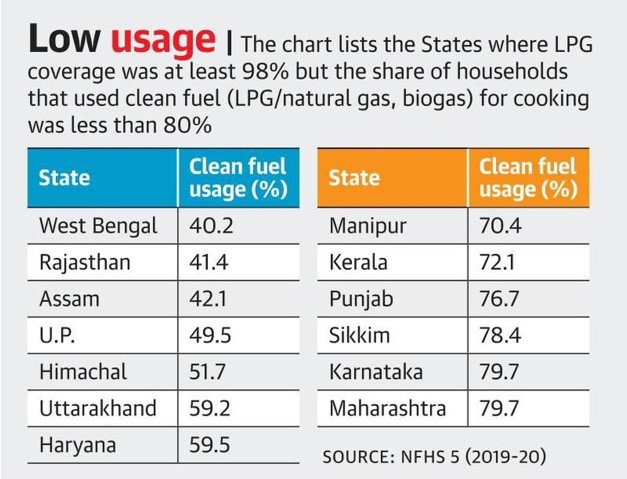
About the Scheme
- Pradhan Mantri Ujjwala Yojana is a scheme of the Ministry of Petroleum & Natural Gas for providing LPG connections to women from Below Poverty Line (BPL) households.
- Provisions: The scheme provides a financial support of Rs 1600 for each LPG connection to the BPL households.
- Along with a deposit-free LPG connection to those low-income families who could not be covered under the earlier phase of PMUY, Ujjwala 2.0will provide the first refill and a hotplate free of cost to the beneficiaries.
- Target:
- Under Ujjwala 1.0,the target was to provide LPG connections to 50 million women from the below poverty line (BPL) households, by March 2020. However, in August 2018, women from seven other categories were brought under the purview of the scheme such as SC/ST, those under the Pradhan Mantri Awas Yojana (PMAY), beneficiaries of the Antyodaya Anna Yojana (AAY), Forest dwellers, MBCs, tea gardens and Islands.
- As Ujjwala Scheme is a part of India’s ambitious agenda for behavioural change thatwill help us transit to a $5 trillion economy by 2024, it is important to fill the gaps with timely intervention and Necessary policy actions.

Source:
- Ujjwala scheme | 90 lakh beneficiaries do not get refills
- Ujjwala Scheme: 90 lakh couldn’t buy even 1st LPG refill in 2021-2022
- Pradhan Mantri Ujjwala Yojana
Image source:
The Red Fort
On May 1648, construction of the Red Fort at Dehli was completed. The Red Fort Complex was built as the palace fort of Shahjahanabad – the new capital of the fifth Mughal Emperor of India, Shah Jahan. Named for its massive enclosing walls of red sandstone, it is adjacent to an older fort, the Salimgarh, built by Islam Shah Suri in 1546, with which it forms the Red Fort Complex. The architecture is a fusion of traditions: Islamic, Persian, Timurid and Hindu. The Red Fort Complex also reflects the phase of British military occupation, introducing new buildings and functions over the earlier Mughal structures. It has been a symbol of power since the reign of Shah Jahan, has witnessed the change in Indian history to British rule, and was the place where Indian independence was first celebrated, and is still celebrated today. The Red Fort was designated a UNESCO World Heritage Site in 2007 as part of the Red Fort Complex and is a monument of national importance under the Ancient Monument and Archaeological Sites and Remains Act, 1959.

Source:
Mullaperiyar Dam Issue
In News
A five-member committee including two technical experts from Tamil Nadu and Kerala inspected the Mullaperiyar reservoir.
About the News
- As per the recent Supreme Court directive, the committee would monitor and maintain the dam until the National Dam Safety Authority was established. The committee is being led by Central Water Commission (Dam Safety Organisation).
- In a status report before the apex court, CWC said that no review on safety was taken place for the last 12 years. However, the same report quotes Empowered Committee constituted by the Supreme Court in 2010 that noted that Mullapperiyar was found to be safe in all respects, hydrologically, structurally, and seismically.
- While Kerala is supporting the call for a fresh safety review by the CWC in its report, Tamil Nadu is using the same report to support its claim that the dam is safe and there is no need for its decommissioning.
About the Mulliperiyar Dam
- The Mullaperiyar dam is located in the upper reaches of the river Periyar, which flows into Kerala after originating in Tamil Nadu.
- Though located geographically in Kerala, the 126-year-old Mullaperiyar Dam is owned, operated, and maintained by the Tamil Nadu government.
- It is a masonry gravity dam.
- The existing dam walls are plastered with rubble masonry to keep its core from high-level water pressure safely. The core of Mullaperiyar is built with hydraulic lime and turki, which is a concoction of crushed bricks, river sand, and a variety of sugar.
- This makes it the only dam of its kind in the world but also makes it difficult to assess the strength of the structure.
- The Mullaperiyar Dam was constructed during 1887-1895 by British engineer John Pennycuick.
- Its full reservoir level is 152 ft and it provides water through a tunnel to Vaigai basin in Tamil Nadu for irrigation benefits.
- A lease indenture for 999 years was made in 1886 between Maharaja of Travancore and Secretary of State for India for Periyar irrigation works. By another agreement in 1970, Tamil Nadu was permitted to generate power also.
What is the current dispute and why it continues?
- The dam is at the centre of a decades-old dispute: for Kerala, where it is situated, the dam presents a threat to lakhs living downstream; and for Tamil Nadu, which controls the dam, the water it provides is the lifeline of people in five districts.
- The disagreement also emanates from the disproportionate benefit to Tamil Nadu from the dam, and the state’s refusal to acknowledge the safety perceptions of those living downstream.
- Kerala has also frequently thwarted efforts by Tamil Nadu to carry out strengthening work on the dam. For instance, in November 2021, it denied permission to Tamil Nadu to cut trees downstream of the baby dam to strengthen it. (The baby dam is one of the four dam structures, which also includes a main dam, earthen dam and spillway).
- Kerala believes any strengthening work on the dam will weaken its own demand for a new dam; Tamil Nadu hopes that completing the safety recommendations will allow it to argue in favour of raising the recommended reservoir level to its maximum capacity.
What are the rising concerns related to safety?
- Existing Problems: The committee, with representatives from the two state governments and a senior officer from the Central Water Commission (CWC), only visits the dam twice a year. Instead, continuous monitoring of both the water levels and the structural strength of the dam is needed.
- Lifespan and Location: Dams have an average lifespan of about 40 years and are typically decommissioned in other countries after this period. The 126-year-old dam, located in a seismically active area, is a ticking time bomb.
- Both Kerala and Tamil Nadu have done nothing to monitor dam deformation at Mullaperiyar using advanced techniques like satellite-based measurements.
- Impact of Climate change: Monsoon patterns in India have changed since the 1900s. There is this increase in short-span heavy rainfall events particularly in central Kerala. Flash floods and landslides have become more common due to these heavy rains.
- Changes in Land Use Patterns: Climatic effects have been aggravated by changes in land use patterns, deforestation in favour of monoculture and excess quarrying. More than half of the forest cover downstream of where the dam is now has been lost since 1900.
Arguments of Stakeholders
Tamil Nadu
- The Tamil Nadu government has steadily maintained that the Mullaperiyar is hydrologically, structurally, and seismically safe.
- The Supreme Court of India allowed the Tamil Nadu government to increase the water level in the dam to 142 feet in 2006. The court later stated that the water level could be increased to 152 feet following strengthening work that was recommended by the expert committee.
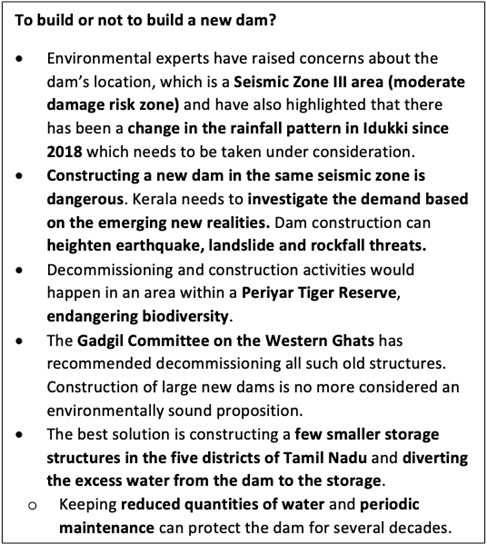
Kerala
- Kerala government has repeatedly raised concerns over the safety of the dam, calling it a threat to millions of people living in downstream of the Periyar River in Kerala.
- Kerala maintains that razing down the existing weak structure and constructing a new dam is the only solution.
Can the 'Dam Safety Act' end Mullaperiyar issue?
- The Supreme Court found in the Dam Safety Act of 2021 a panacea to end the “perennial” legal battle between Tamil Nadu and Kerala over the Mullaperiyar dam.
- The Central statute, which came into force recently, mandates setting up of two specialised bodies, National Committee on Dam Safety and National Dam Safety Authority (NDSA) to evolve policies, recommend regulations for dam safety standards and resolve disputes between the States.
- As the act provides that NDSA would perform the role of the State Dam Safety Organisation for a dam located in one State and used by another, the Mullaperiyar dam comes under the purview of the NDSA.
- Further, the court could extend the powers of its supervisory committee to take over charge of the safety and maintenance of the structure.
Way forward
The centre and court needs to intervene, and ensure a fair process takes way to arrive at a solution at the earliest. Complete coordination among stakeholders for ensuring fair trial could be the way forward. This is possible by creating an independent group of experts to check existing technical reports and to collect and analyse dam deformation data, to decide on the dam’s future stability prospects.
Governments can manage potential disasters better by integrating rain forecasts from the Indian Meteorological Department with better calibrated reservoir management and water discharge systems.
Question: What makes the Mulliperiyar dam a contentious issue?
Sources:
- SC-appointed committee inspects Mullaperiyar dam:
- Debate over Mullaperiyar dam’s safety continues with opposing views in Kerala and Tamil Nadu:
- The 126-year-old dam that stands between Kerala and Tamil nadu:
- Mullaperiyar dam: old dispute between Tamil Nadu & Kerala, revived after recent rains:
- MULLA PERIYAR DAM ISSUE:
- UN report on threat to ageing dams in India mentions Kerala’s Mullaperiyar:
- Mullaperiyar row | Dam Safety Act can end disputes, says Supreme Court:
- Safety first: On Mullaperiyar dispute:
Plant in Lunar Soil
This is image of Arabidopsis thaliana in the nutrient-poor lunar regolith, by NASA-funded researchers. This research is critical to NASA’s long-term human exploration goals as resources found on the Moon and Mars will have to be used to develop food sources for future astronauts living and operating in deep space. This fundamental plant growth research is also a key example of how to unlock agricultural innovations that could help us understand how plants might overcome stressful conditions in food-scarce areas here on Earth. Arabidopsis thaliana, native to Eurasia and Africa, is a relative of mustard greens and other cruciferous vegetables like broccoli, cauliflower, and Brussels sprouts.
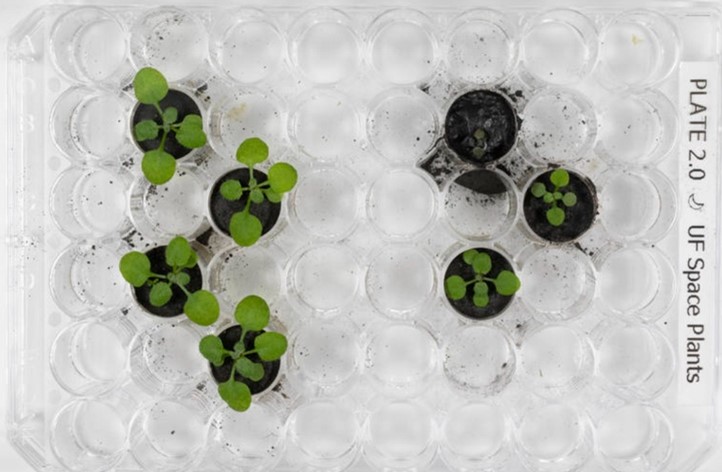
Source:
Tomato flu - Edukemy Current Affairs
- Context: Karnataka and Tamilnadu have ramped up surveillance at their borders in the wake of the recently detected “tomato flu” cases in Kerala.
- Tomato Flu is a rare viral disease, which causes red-coloured rashes, skin irritation and dehydration.
- The disease gets its name from the blisters it causes, which look like tomatoes.
- This unidentified fever has been found in Kerala among children below five years of age.
- The major symptom of the disease includes large blisters, high fever, body ache, joint swelling and fatigue, similar to that of Chikungunya.
- Like other cases of flu, tomato fever is also
- It is a self-limiting one and there is no specific drug for this which means that the symptoms will resolve overtime with Maintenance of hygiene, proper rest along with hydration.

Source:
- Tomato Flu: Five Karnataka-Kerala border districts to be on alert, says Sudhakar
- Explained: What is tomato flu? Who does it affect?
Image source:
Gyanvapi mosque - Edukemy Current Affairs
- Context: The Varanasi court has recently ordered the continuation of survey and videography inside the Gyanvapi Mosque, adjacent to the Kashi Vishwanath Temple.
- The Gyanvapi Mosque is believed to have been built in 1669 during the reign of the Mughal emperor Aurangzeb, who ordered the demolition of the existing Vishweshwar temple and its replacement by a mosque.
- The plinth of the temple was left untouched and served as the courtyard of the mosque.
- One of the walls too was spared, and it became the qibla wall, the most ornate and important wall in a mosque that faces Mecca.
- Material from the destroyed temple was used to build the mosque.
- The name of the mosque is said to have derived from an adjoining well, the Gyanvapi, or Well of Knowledge.
- For more than 100 years after the mosque was built, there was no temple at the site. The present Kashi Vishwanath Temple was built in the 18th century by Rani Ahilyabai Holkar of Indore, immediately to the south of the mosque. Over the decades it emerged as one of the most prominent and revered centres of the Hindu religion.
- An old sculpture of the Nandi bull inside the compound of the Temple faces the wall of the mosque, which is believed to be the original sanctum sanctorum of the Vishweshwar temple.
- The mosque is not an Archaeological Survey of India protected site.
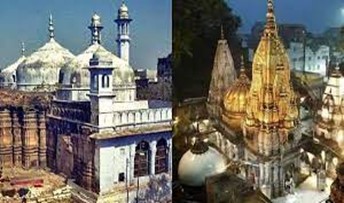
Source
- Gyanvapi Mosque video survey to continue, court seeks report by May 17
- Court order on Kashi Vishwanath Temple-Gyanvapi Mosque site in Varanasi: history and context
Image source
Mission Amrit Sarovar - Edukemy Current Affairs
- Context: Recently, a review meeting on the progress of Mission Amrit Sarovar was attended by all States.
- Mission Amrit Sarovar is aimed at developing and rejuvenating 75 water bodies in each district of the country.
- The Mission was launched on 24thApril 2022, with a whole of Government Approach in which 6 Ministries/Department namely Department of Rural Development, land resources, Drinking Water and Sanitation, Water resources, Ministry of Panchayati Raj, Forest, Environment and Climate change.
- Technology will be used in every phase of execution of the project and Bhaskaracharya National Institute for Space Application and Geo-informatics (BISAG-N) has been engaged as Technical partner for the Mission.
- People’s participation in the Mission is its focal point.
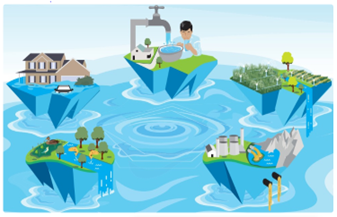
Source:
- Mission Amrit Sarovar- A high level meeting held to review the progress of the Mission under the chairmanship of Secretary, Rural Development
- Rural development Secretary chairs meeting with states to review progress of Mission Amrit Sarovar
Image source
Chief Election Commissioner - Edukemy Current Affairs
- Context: The President has recently appointed Rajiv Kumar as the Chief Election Commissioner in the Election Commission of India.
- The appointment was done in pursuance of clause (2) of article 324 of the Constitution.
- The Chief Election Commissioner of India (CEC)heads the Election Commission of India, which is a constitutional body under the Ministry of Law and Justice.
- It is a permanent and an independent body established by to ensure free and fair elections in the country.
- The President of India appoints the Chief Election Commissioner (CEC) of India who hasa tenure of 6 years or up to 65 years, whichever is earlier.
- He/she enjoy the same statusand receive salary and perks as available to Judges of the the Supreme Court.
- He/she can be removed by the President on the basis of a resolution passed to that effect by both the Houses of Parliament with special majority, either on the ground of proved misbehaviour or incapacity.
- Both the CEC and the other Election Commissioners have equal sayin the decision making of the Commission.
- The service conditions of the chief election commissioner cannot be varied to his disadvantage after his appointment.
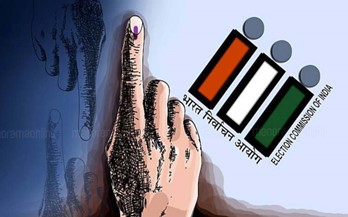
Source:
Image source
Monetary policy alone won’t bring down inflation: Indian Express
Essence: The editorial talks about the context of inflation in India in the last 2 years, measures taken by RBI to control it and the underlying flaws and gaps in the policy. RBI has raised the policy rates, Repo rate and CRR to cut back liquidity available in the market. The editorial points at the debate if this is the optimal measure to control inflation in India.
There are 3 ways to control inflation- lower inflationary expectations (by RBI’s commitment and actions), having high rates of interest to attract foreign capital (would appreciate domestic currency and lower import rates) and curbing credit growth and transmission.
India has barely recovered from Covid’s impact on economy. Moreover, the inflation is related to supply side constraints- higher food and commodity prices, supply chain disruptions, and formalization of economy (increase in transaction cost). None of these factors are affected by tightening monetary policy. There is certainly a reason to extract the excess liquidity from the market, however, such higher interest rates would slow GDP growth. What is needed now is to bring down geo-political tensions, make changes in China’s zero-covid policy, fiscal support from government to vulnerable and potential sectors and repair the disrupted domestic supply chain.
Why should you read this article?
- To understand the causes of inflation and ways to tame the same.
- To know the history of RBI policy measures taken in the last decade to control inflation.
Source:
Let’s not compare economies of Nepal and Sri Lanka: Indian Express
Essence: The editorial talks about the comparison of India’s neighboring economies- Nepal and Sri Lanka, their GDP growth, current account deficit due to economic fallout and possible future course of action. Nepal’s economy is growing fairly post covid, at 6% in the present quarter. But its current account deficit has risen to 9.5% of GDP due to high imports. It has resulted in lesser foreign exchange inflow. Nepal is supported by high remittances, hydroelectricity contracts with its neighbors- India and Bangladesh and reviving tourism (2.2 per cent of Nepal’s GDP compared to 4.9 per cent for Sri Lanka) and promoting domestic production. Nepal has a relatively low public debt (40% of GDP with 23% being external debt).
Sri Lanka, a nation with higher social indicators with comparable economies, has always paved its policies around investment and export promotion. The present issues revolve around balance of payment crisis, due to reduced tourism (post 2019 terrorist attacks), covid export shocks, lesser flow of remittance and high external debt.
Both economies, surrounded by India, could recover with India’s huge potential to grow economically through meaningful partnerships.
Why should you read this article?
- To know about the comparison of Nepal and Sri Lanka economy.
Source:
Let's count down 124A: Why sedition law has no place in a democracy: Economic Times
Essence: Section 124A (anti-sedition provision) has been suspended on the centenary of Gandhi's arrest under the same section for publishing an Article in “Young India”. In that historic trial Gandhi ji pleaded not guilty and asserted that it was his duty to oppose a government which was working against the interest of the Country and her people. He had questioned this law when a foreign government was ruling. Continued presence of this law makes much less sense when we are a democracy now.
The Supreme Court’s order is a welcome relief, but we must remember that it is a temporary relief. Author hopes that Section 124A will soon be rendered unconstitutional and struck off from the law books of India.
Why should you read this article?
- To understand the historical background of Sedition law in India.
Source:
ASHA Didi in Forbes
Background
- Matilda Kullu, an Odisha tribal ASHA worker, has been listed in the Forbes India W-Power 2021 list for her humanitarian
- The Forbes India W-Power 2021 list is notable for women who have overcome adversity and strived to make a difference.
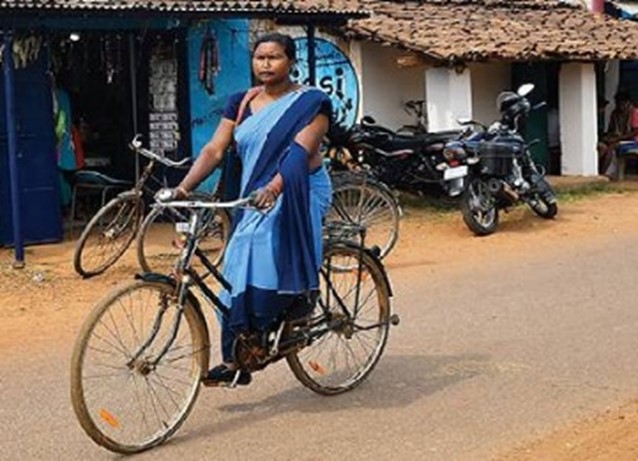
About Matilda Kullu
- Matilda Kullu, from Odisha, has been a recognised social health campaigner for the past 15 years.
- Known as Asha didi, she has played a key role in raising awareness about Covid-19 treatments, precautions and vaccination. She has also been involved in Covid-19 testing.
- She was instrumental in altering the thinking of the villagers by raising information about the treatments and medicines needed to cure any sickness. Instead of going to the tantrik for therapy, the villagers now go to a doctor.
- Every day, she rides her bicycle across the village, making door-to-door visits to gather health-related information from the residents.
- Women are provided advise on newborn and teenage girl immunisation, prenatal check-ups, delivery preparation, nutritious eating for pregnant women, and so on.
Quote: "Real education should educate us out of self into something far finer; into a selflessness which links us with all humanity."- Nancy Astor.
Source:
Share the article
Get Latest Updates on Offers, Event dates, and free Mentorship sessions.

Get in touch with our Expert Academic Counsellors 👋
FAQs
UPSC Daily Current Affairs focuses on learning current events on a daily basis. An aspirant needs to study regular and updated information about current events, news, and relevant topics that are important for UPSC aspirants. It covers national and international affairs, government policies, socio-economic issues, science and technology advancements, and more.
UPSC Daily Current Affairs provides aspirants with a concise and comprehensive overview of the latest happenings and developments across various fields. It helps aspirants stay updated with current affairs and provides them with valuable insights and analysis, which are essential for answering questions in the UPSC examinations. It enhances their knowledge, analytical skills, and ability to connect current affairs with the UPSC syllabus.
UPSC Daily Current Affairs covers a wide range of topics, including politics, economics, science and technology, environment, social issues, governance, international relations, and more. It offers news summaries, in-depth analyses, editorials, opinion pieces, and relevant study materials. It also provides practice questions and quizzes to help aspirants test their understanding of current affairs.
Edukemy's UPSC Daily Current Affairs can be accessed through:
- UPSC Daily Current Affairs can be accessed through Current Affairs tab at the top of the Main Page of Edukemy.
- Edukemy Mobile app: The Daily Current Affairs can also be access through Edukemy Mobile App.
- Social media: Follow Edukemy’s official social media accounts or pages that provide UPSC Daily Current Affairs updates, including Facebook, Twitter, or Telegram channels.



